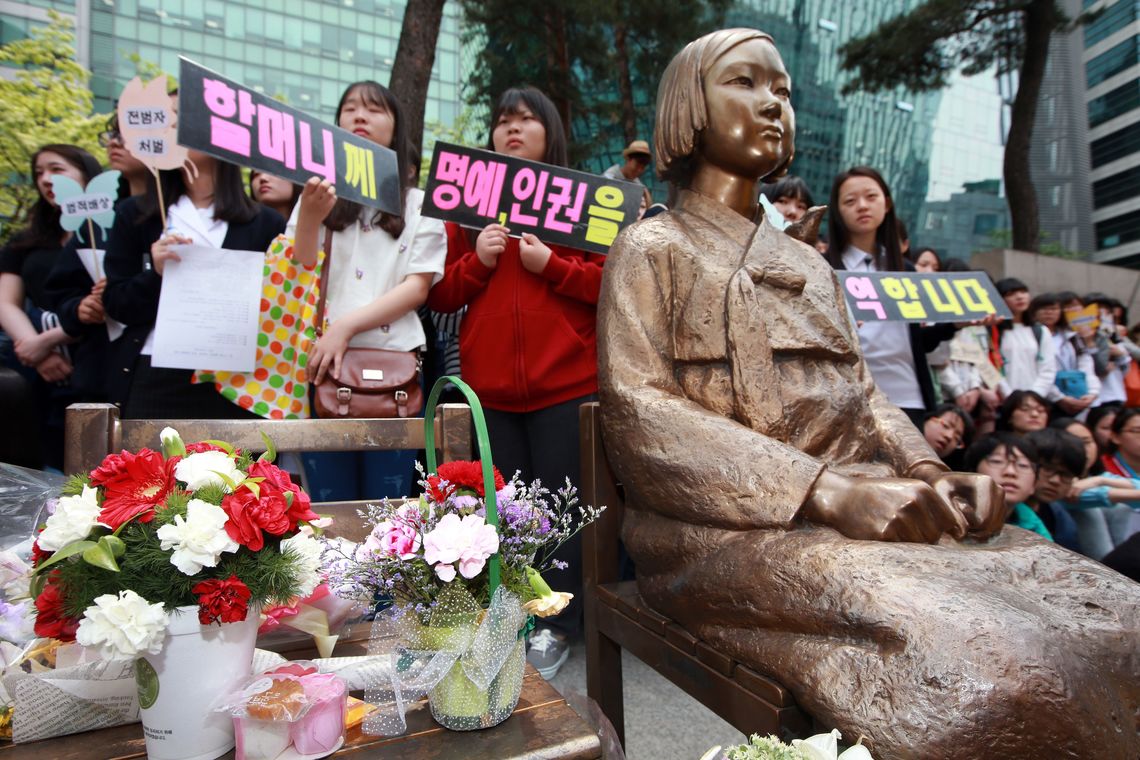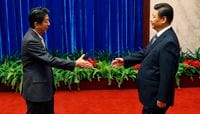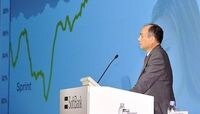
──I am hoping to explore with you both the substance of the Open Letter, and how the Letter came about, and then look a little bit at some criticisms that have emerged in the few days since the publication.I’ll direct a question to one of you, and the other can then respond.Professor Sand, let me put this question to you. The Wall Street Journal and the Financial Times both characterized the Open Letter as a “rebuke” of Prime Minister Shinzo Abe. Is that an accurate description of the spirit of the Letter, and does it capture your intention?
SAND: The Letter addresses our colleagues in Japan, the public, the media, and the government. We expressed hopes for action from the government on the issue of “comfort women.” I believe, and I think most of the signees believe, that there is a lot the prime minister could do. But I did not participate in order to rebuke the prime minister. I don’t think that’s our role. It is not mistaken to read it as a rebuke, but that does not capture the intent of the Letter.
DUDDEN: I agree. The headlines on those stories, using the work “rebuke,” were not incorrect. But that is not why 187 historians and scholars became involved. The Letter is a collective reflection on a new environment in Japan that is often inhospitable to objective historical inquiry on certain topics. This is quite different from even the recent past. The signers of the letter have all made Japan the center of their professional lives. Something new has emerged in Japan in the last year or two to the extent that putting together a common reflection on this trend by such a divergent group of people turned out to be remarkably easy.
SAND: You could even say the Letter was intended more as an encouragement than a rebuke. The Letter is a collective expression of opinion, not a set of demands to the government. Japan is a democratic society, and the prime minister is an elected official. He can answer his own constituents. We didn’t presume to tell the prime minister what he “must” or “must not” do. But the government bears some responsibility for the climate in Japan around the “comfort women” issue. The Letter is a comment on this worrisome climate. The government has the power to change that.
──Professor Sand, would you elaborate a bit on the “climate” you refer to?
SAND: Let me be specific. The timing of the release of the Letter gave the appearance that it was somehow responding to the prime minister’s recent visit to the US. But I started talking with colleagues about putting together some kind of statement last year. At the time, I had no idea Abe would be making a visit to the US. Many scholars here were disturbed by reports of intimidation of journalists, and we found colleagues of ours in Japan saying that because of receipt of government funding, they would not be able to work on certain issues. In the political sphere, it was becoming common to hear callous statements about the surviving victims of the comfort women system passing as everyday political speech. It struck me, and many others, as a strange turn in discourse. It felt like it was time to comment, as friends and colleagues. I should also say that I’ve found many friends in Japan who are not academics who are tired from so-called “apology fatigue.” These are good friends of mine. They just want the whole issue to go away. And I thought it was important to step back, and say that the issue has not gone away because it remains unresolved.
Those were my sentiments. So a few of us decided we would get a group together to discuss this at the March meeting in Chicago of the Association of Asian Studies annual conference. A few weeks before the conference, I visited Japan, still thinking about how to address these concerns at the AAS meeting. In Japan, I was astonished once again at the degree to which important and intelligent mainstream people were saying off-base things, such as: “This generation of American scholars are anti-Japan,” and ridiculing serious scholars and newspapers. And I thought: “Wow, Japan has become a hot-house for this kind of thinking.” Now, Japan is a very cosmopolitan place. So this deepened my conviction that we should try to blow some fresh air in from the outside, even if this ran the risk of appearing to be patronizing.
DUDDEN: We got 187 scholars with wildly divergent specializations to come together based on each of us noticing a troubling atmosphere. A lot of the recent presentation of the comfort women issue has been quite constricted. It is not full-on censorship from the highest level. Rather, there seems to be a narrowing of what is considered permissible speech. So a lot of people are losing sight of the fact that it is not all the fault of the “other side” – Team China, or Team Korea. The notion that Japan has “done enough” becomes pervasive, such that even the mildest of critiques of current Japanese policy defines one as “pro-China” or “pro-Korea.” And within the world of Japanese politics, those who want to really reach out to China and Korea, while still on the scene, are far from the councils setting the country’s policy agenda. That is a recent development, and it undercuts the notion of Japan being a regional leader. Much of the region looks to Japan as the open society. When the confines of “permissible” discussion in Japan become more narrow, Japan’s aspirations for regional leadership become more difficult to realize. Still, we tried to operate as quietly as possible.
──When you arrived in Chicago for the March AAS meeting, were there already discussions underway to initiate the writing of a Letter?
SAND: There were multiple conversations already underway. The issue of Foreign Ministry pressure on McGraw-Hill had sparked some conversations. There were conversations about the bashing of the Asahi Shimbun over articles that had long ago been retracted. The whole environment in Japan seemed to have taken a turn toward intolerance. By last December I concluded that some kind of statement would be appropriate, or at least possible. By February, Alexis and I were in email contact with old friends, and we discussed reserving a room in Chicago where those who shared our concerns and were attending the AAS meeting could get together for a discussion.
DUDDEN: We are not an organization of any kind, so we did not have a room of our own automatically available at the AAS meeting. We had to reserve one ourselves. The annual AAS meeting is really the only time that a good number of Japan specialists gather in one spot, so we were cognizant of the fact that if we were going to have momentum for the issuance of a Letter, we would have to have our act together going into the Chicago meeting.
SAND: I reserved a room for 11:30 pm, because that was the only time everyone was free. I was thinking that we would discuss whether as a group we could come up with a statement, what we have the right to say, and whether a statement would be constructive. The conversation was very constructive, but at that point still pretty inconclusive. Lots of good ideas were shared, but we did not resolve what exactly we wanted to say, and what would be the best way to say it. And to whom?
After the AAS meeting, Alexis and I played the role of on-line switchboard. About 30 people were present at the late-night meeting in Chicago, and they wanted to stay in the loop. They talked with other people, some of whom came on board. Drafts of a Letter started to circulate. It was all quite messy; organic. At a certain point, the content coalesced, and enough people had seen a draft that they thought was at least close to right.
──Was there one person who wrote the initial draft?
DUDDEN: Nice try! It was written by 187 people!
SAND: I would call myself the secretary. I sketched out the main points of the first meeting and circulated them. Over a month-and-a-half, I kept putting in new commas, and taking out old semicolons, until everyone saw a final document that a large number of us could live with. At that point, the draft had circulated to so many people that we worried a bit that it might be released unfinished and we felt pressure to finalize the whole process. We gave everyone 24 hours to look at both the English and Japanese final versions, to recuse themselves if they decided the final version did not reflect their own opinion, and to otherwise make sure their respective names were spelled correctly.
We had to battle to keep the Letter from being too long. Every time someone suggested an addition, the Letter got longer and longer.
DUDDEN: Some people wanted footnotes. From the other side, there was a group from the Midwest that wanted to keep the Letter to 500 words, or they would not sign. It says a lot about the strong sentiments on the issues we raised that 187 academics were willing and able to come together behind the Letter.
──There were roughly 30 people in this core group that collectively put the Letter together?
DUDDEN: There is an exact list of 29 people who made up the core. And there were 5-6 people who were deeply involved in the drafting of the Letter, throwing back at Jordan every adjective, comma, and semicolon they did or didn’t like.
SAND: The whole process took over a month even though I think the Letter consists of rather commonsense prose.
──How did you go from the core of 30, to 187 signatories?
SAND: The final version was circulated by the original 30.
DUDDEN: To people they knew.
SAND: That’s right. This was meant as a statement from scholars of Japan based outside of Japan, so we circulated to colleagues in North America, Europe, and Australia. Some colleagues in Japan saw it, but we wanted this to be a message that came from outside of Japan.
DUDDEN: We are cognizant that the Letter might come across as a bunch of westerners telling Asians what to do. But we were influenced by the statement issued late last year by the Historical Science Society of Japan (Rekishigaku kenkyukai) that was sharply critical of the Abe administration’s stance toward the comfort women issue.
SAND: Many people read the Rekishigaku kenkyukai statement, and it really resonated. But we are not an organization of any kind. The Letter was issued by a group of people who were persuaded that “this much we can all agree on, this much we believe is common sense.” There are people involved in this who have never had their names printed on the same page, anywhere. Some of them may not be willing to appear in the same room with each other. But we all shared the statement.
──Did you deliberately issue the Letter after Prime Minister Abe’s visit to the US?
SAND: Yes. We had a draft that many people saw before the prime minister arrived. A number of people commented that we couldn’t very well issue the Letter until we’ve heard what he has to say. I felt that the Letter was not all about addressing Prime Minister Abe, but the point came through to me. We owed Abe the respect to let him come, address American audiences, and see what he says on the issues we raise. And the final version made reference to the more inspiring comments the prime minister made in his address to Congress. We did not want to rush the Letter out to have it somehow tied to the visit. It just so happened that the draft had already circulated far and wide so it was time to finalize.
──What about the paragraph on nationalism? I initially took it to mean that some people in the drafting process thought it would be important to reference nationalism in Korea and China so that the Letter not appear to be ganging up on Japan.
SAND: Everyone accepted that passage, though there were a few people who raised concerns that in some ways it is ahistorical. The roots of nationalism are profoundly different in different places, and of course in this case we are talking about the country of the perpetrator and the countries of the victims. To paint the nationalism we’ve seen in China, Korea, and Japan regarding comfort women with a single brush might appear to be very facile. But everyone agreed that at the present moment, on this issue, you can’t ignore that nationalism is a problem far from unique to Japan. The comfort women issue is made even more complicated than it already is by the nationalism surrounding the issue in all three countries.
DUDDEN: Many of us who have published writings specifically on the comfort women issues have stated up front that nationalism in all three countries is an obstacle to resolution. The Letter, however, tries to return to what we do in the classroom, which is to focus on the substance of what happened: the brutality of this particular history. People who throw history around as a weapon tend to forget what actually happened on the ground, which transcends national boundaries.
SAND: The whole statement is about the ethics of doing history, and the responsibility of governments to protect and respect the work of historians.
──Prime Minister Abe has already said that he does not plan to use the key language from the Murayama Statement when he issues his own statement on World War II in August. Are you concerned that the upcoming statement will not bring Japan and its neighbors any closer to reconciliation, and might even worsen relations?
SAND: Alexis and I come at this from different specialties, so the question is best put to her. The politics of war memory and apology is a central research issue for her and a topic about which she writes. For my part, I of course believe the Japanese government has the power to make changes toward reconciliation. But I am less engaged in the diplomatic issues. I wanted to play the role of “switchboard” in the compilation of the Letter partly because I am not heavily involved in the issue, and felt I could channel the common sense of colleagues and bring opinion together.
DUDDEN: In my view, the current government in Japan seems determined to play with words, to divert attention from what really happened, and what needs to be said to move forward. It is disheartening that in this very important anniversary year, a nation that has acted in peace and with respect for human rights over the past 70 years sees its top leaders objecting to rather common sense assessments of what occurred in Asia in World War II.
──In his Statement in 1995, Prime Minister Murayama stated that “Japan must eliminate “self-righteous nationalism.”
SAND: We were in touch with some very prominent political scientists who have influence in Japan. For the most part, they said they are working through other channels, and chose not to sign. But several said: “I hope you will convey to the Japanese government how bad it is for Japan that this type of nationalism is still kicking around.” It seems so obvious.
──At least one critic in Japan has gotten considerable attention by claiming there is a split between you two, with Professor Dudden interpreting the Letter with a decidedly anti-Japan twist, and Professor Sand remaining more objective.
DUDDEN: There is no division between us. Whoever says there is a split has a gross misunderstanding.
SAND: Alexis and I were the two people who sent out the final version, which raised the question: what should we call ourselves? I suggested that we were two co-coordinators. We got the room at the AAS, we carried the whole thing forward on-line with the group of 30 or so. We decided on the deadline, and gave everyone involved their final say. And then we sent it out. But all of that is different from being the representatives, or spokespeople for the 187 signatories. Alexis has been on the public record on this topic many times. Her email inbox was filled with messages, many of them quite nasty. In many respects the Japanese language version of the Letter has turned out to be the more important one, because I expect more people are reading it. It was co-translated by me and Asano Toyomi of Waseda University. He is very devoted to the document, and he turned it into beautiful Japanese.
The Letter went all over the media. Sometimes it has been misrepresented in the media, and sometimes fairly represented. Lots of media have printed the whole document.
DUDDEN: We sent the Letter to the Cabinet Office, in both languages, out of respect. We offered the Letter to Yomiuri Shimbun on an exclusive basis, but we never heard back from the paper. Then we gave the Letter to about 10 people for whom I had meishi on my desk. Most of them were Japanese reporters. I sent it to the New York Times and the Washington Post, and then to Bloomberg and the Korean news agency Yonhap. I had worked with a Yonhap reporter the week before at a conference. Subsequently, this turned into me being “pro-Korea,” and me “manipulating” Jordan. Frankly, it is absurd. Some critics in Japan cited a Yonhap dispatch that I asserted I was the leader of the push for the Letter. I never said that; the Yonhap reporter wrote that. As we explained, I was one of the leaders, but one among many. Somehow the notion emerged that I led the push for the Letter in an effort to damage Japan. But this plays into something that has been going on inside Japan for over a year. I’ve been labeled as “anti-Japan,” which of course I am not. But that label is very difficult to defend yourself against.
The Letter is not about me, or Jordan, or any other individual. This is 187 scholars, some of them very big names, who share a concern about a worrisome trend in Japan on history issues, in this case comfort women. That is a big deal.
Japan is an open society. We’d like to add to the debate in a productive manner. Unless there is discussion inside Japan, nothing else will matter.
SAND: We haven’t gotten caught up in any of the commentary. We know we live in the age of the 24-hour, second-by-second media world. And we issued the Letter during Golden Week, so a lot of people we sent it to were probably not paying attention. I expect this week could be ‘smear week.’ Kobayashi Yoshinori has already started in.
We wrote a statement that we all feel strongly about. We are historians. We know that we can stand back, and it will either speak to people on its own terms, or it won’t. Any negative comments said around it are just part of that day’s news cycle.




